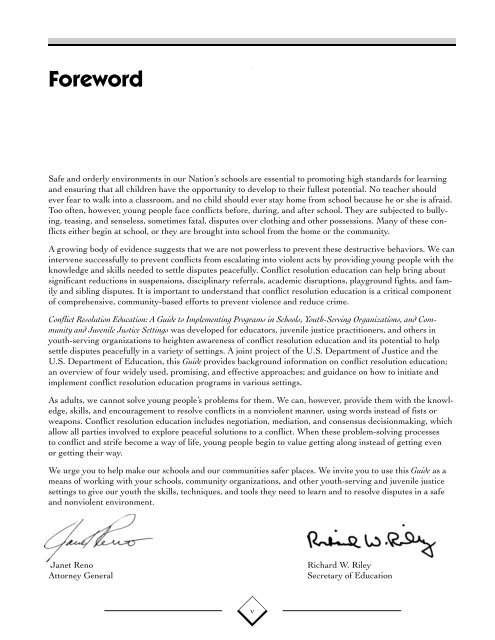Conflict Resolution Education - National Criminal Justice Reference ...
Conflict Resolution Education - National Criminal Justice Reference ...
Conflict Resolution Education - National Criminal Justice Reference ...
You also want an ePaper? Increase the reach of your titles
YUMPU automatically turns print PDFs into web optimized ePapers that Google loves.
Foreword<br />
Safe and orderly environments in our Nation’s schools are essential to promoting high standards for learning<br />
and ensuring that all children have the opportunity to develop to their fullest potential. No teacher should<br />
ever fear to walk into a classroom, and no child should ever stay home from school because he or she is afraid.<br />
Too often, however, young people face conflicts before, during, and after school. They are subjected to bullying,<br />
teasing, and senseless, sometimes fatal, disputes over clothing and other possessions. Many of these conflicts<br />
either begin at school, or they are brought into school from the home or the community.<br />
A growing body of evidence suggests that we are not powerless to prevent these destructive behaviors. We can<br />
intervene successfully to prevent conflicts from escalating into violent acts by providing young people with the<br />
knowledge and skills needed to settle disputes peacefully. <strong>Conflict</strong> resolution education can help bring about<br />
significant reductions in suspensions, disciplinary referrals, academic disruptions, playground fights, and family<br />
and sibling disputes. It is important to understand that conflict resolution education is a critical component<br />
of comprehensive, community-based efforts to prevent violence and reduce crime.<br />
<strong>Conflict</strong> <strong>Resolution</strong> <strong>Education</strong>: A Guide to Implementing Programs in Schools, Youth-Serving Organizations, and Community<br />
and Juvenile <strong>Justice</strong> Settings was developed for educators, juvenile justice practitioners, and others in<br />
youth-serving organizations to heighten awareness of conflict resolution education and its potential to help<br />
settle disputes peacefully in a variety of settings. A joint project of the U.S. Department of <strong>Justice</strong> and the<br />
U.S. Department of <strong>Education</strong>, this Guide provides background information on conflict resolution education;<br />
an overview of four widely used, promising, and effective approaches; and guidance on how to initiate and<br />
implement conflict resolution education programs in various settings.<br />
As adults, we cannot solve young people’s problems for them. We can, however, provide them with the knowledge,<br />
skills, and encouragement to resolve conflicts in a nonviolent manner, using words instead of fists or<br />
weapons. <strong>Conflict</strong> resolution education includes negotiation, mediation, and consensus decisionmaking, which<br />
allow all parties involved to explore peaceful solutions to a conflict. When these problem-solving processes<br />
to conflict and strife become a way of life, young people begin to value getting along instead of getting even<br />
or getting their way.<br />
We urge you to help make our schools and our communities safer places. We invite you to use this Guide as a<br />
means of working with your schools, community organizations, and other youth-serving and juvenile justice<br />
settings to give our youth the skills, techniques, and tools they need to learn and to resolve disputes in a safe<br />
and nonviolent environment.<br />
Janet Reno Richard W. Riley<br />
Attorney General Secretary of <strong>Education</strong><br />
v

















